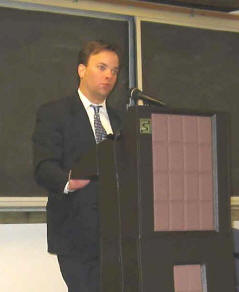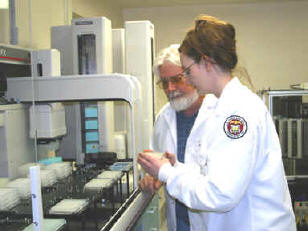April
2003, Volume 1, Issue 3
FDA Commissioner Visits NCTR
On Wednesday, February 12, 2003, Dr. Mark McClellan, Commissioner of the Food
and Drug Administration, visited the Jefferson Laboratories. Dr. Dan Casciano,
NCTR Director, presented an overview of NCTR. Highlights of NCTR’s work in Risk
Assessment/Management, Toxicoinformatics, Structural Genomics, Food Safety, and
Counterterrorism were outlined by each area’s director. Dr. McClellan toured the
Phototoxicology Center, the Neurotoxicology and Functional Genomics areas, and
the Arkansas Regional Laboratory.
At an "All-Hands Meeting," Dr. McClellan identified the FDA’s new strategic
goals as 1) Strong FDA, 2) Risk Management, 3) Better Informed Consumers, 4)
Patient Safety, and 5) Counterterrorism. He emphasized that research being
conducted at the Jefferson Laboratories directly relates to these strategic
goals and the results will have a major impact on the public’s safety and
health.
"We [the FDA] are the world’s foremost science-based regulatory agency. The
NCTR plays a critical role in the mission of the Agency. … This is a place
where you can make a tremendous difference, … where your career can have a
major impact." Dr. Mark McClellan

Above image is of Dr. Mark McClellan, FDA
Commissioner, responds to a question from a Jefferson Laboratories staff
member. Photo/Danny Tucker
ABI Meets at NCTR
The Arkansas Biosciences Institute (ABI) is a partnership of scientists from
the University of Arkansas Division of Agriculture, the University of Arkansas
for Medical Sciences (UAMS), the University of Arkansas at Fayetteville,
Arkansas Children’s Hospital, Arkansas State University, the Arkansas Science
and Technology Authority and the NCTR.
The Arkansas Biosciences Institute was created as part of the Tobacco
Settlement Proceeds Act to foster collaborative efforts between the member
institutions and to conduct and promote research in the fields of agriculture
and medicine, focusing particularly on tobacco and cancer-related illness. The
new building to house the ABI is being constructed on the campus of the UAMS.
On Friday, January 24, 2003, NCTR hosted a meeting of the ABI. After updates
by ABI member institutions, Dr. Dan Casciano, Director of NCTR, reported on
ongoing collaborative research projects at NCTR. Dr. Casciano and Dr. Paul
Howard, Director of NCTR’s Center for Phototoxicology, then led the group in a
tour of NCTR.

In the image above, William Branham and Cathy
Melvin demonstrate the process of creating microarrays at the Center for
Functional Genomics Open House. Photo/Shirley
Dawson.
Center for Functional Genomics
Did you know that technologies developed as a result of the Human Genome
Project can help assess toxicity of everyday products used by the public?
NCTR’s Center for Functional Genomics will 1) assess changes in genes to
investigate the relationship between chemical exposure, toxicity and disease, 2)
develop standard DNA-based testing methods that will be directly applicable to
regulatory science, and 3) use microarray-generated data to develop new, more
relevant, predictors of human toxicity.
On February 2, 2003, the Center for Functional Genomics held an Open House.
NCTR staff enjoyed viewing a demonstration of the process of creating a
microarray and sampling "microarray cookies."
Jefferson Lab "Trail Blazers"
By Priscella Sullivan
There are "trail blazers" among us! Vicky Culp and Rudy Rieple have been
selected as the Department of Health and Human Services Energy Champions as part
of the You Have the Power campaign. The campaign, an initiative funded by the
U.S. Department of Energy, spreads the word about saving energy costs and
resources among Federal workers.
Vicky and Rudy are responsible for the first competitively awarded natural
gas contract for Jefferson Labs since deregulation. The pie´ce de re´sistance is
that it resulted in a budget savings of $220,000. Thanks Vicky and Rudy for your
efforts.
Vicky and Rudy follow in the footsteps of the "Innovator," Bruce Rice, who
won the prestigious distinction in 1998.

In the image above are Vicky Culp and Rudy Rieple,
recipients of the prestigious DHHS Energy Champions Award. Photo/Danny
Tucker.
Recent Publications:
NCTR conducts research designed to protect the public’s health. Results from
some of these research projects have recently been accepted for publication in
nationally recognized scientific journals.
- Billedeau, S.M., Development of Methods for Analysis and Confirmation of
Erythromycin A Residues in Tissue Samples from Terrestrial and Aquatic Farmed
Animals by Liquid Chromatography, J. Agricultural and Food Chemistry.
- Billedeau, S.M., LC Analysis of Erythromycin A in Salmon Tissue by
Electrochemical Detection with Confirmation by Electrospray Ionization/Mass
Spectrometry, J. Agricultural and Food Chemistry.
- Ferguson, S.A., Dietary Ethinyl Estradiol Exposure during Development
Causes Increased Sodium Intake and Mild Maternal and Offspring Toxicity in
Rats: An Indication of Male Feminization and Female Hyperfeminization?,
Journal Hormones and Behavior.
- Morris, S.M., Effect of Dietary Genistein on Cell Replication Indices in
C57BL6 Mice, Cancer Letters.
- Ratnasinghe, L., Gene-environment Interactions between Codon 194
Polymorphisms of XRCC1 and Antioxidants Influence Lung Cancer Risk,
Anti-Cancer Research.
- Scallet, A.C., Dietary Exposure to Genistein Increases Vasopressin, but
Does Not Alter B-endorphin, in the Rat Hypothalamus, Toxicological Sciences.
- Schmued, L.C., Demonstration and Localization of Neuronal Degeneration in
the Rat Forebrain Following a Single Exposure to MDMA, Brain Research.
- Slikker, W., Childhood Obesity: Possible Causes and Public Health Impact,
Journal of Children's Health.
- Snellings, S.L., Rapid Colorimetric Method to Detect Indole in Shrimp with
Gas Chromatography Mass Spectrometry Confirmation, Journal of Food Science.
- Thai, S., Altered Gene Expression in Mouse Livers After Dichloroacetic
Acid Exposure, Mutation Research.
- Turesky, R., The Effects of Coffee on Enzymes Involved in Metabolism of
the Dietary Carcinogen 2-amino-1-methyl-6-phenylimidazo[4,5-b]pyridine in
Rats, Chemico-Biological Interactions.
On-Line Research Information:
Regulatory Research Perspectives: Impact on Public Health, an on-line
newsletter that provides a vehicle for FDA scientists to communicate important
scientific information, and NCTR’s FY 2002-2003 Research Accomplishments and
Plans are available from NCTR’s web site at
http://www.fda.gov/nctr/science/science.htm.
Contact Information:
The NCTR Quarter Page is published four times a year by the Division of
Planning at the National Center for Toxicological Research.
For more information about NCTR, contact Dr. Dan Casciano, NCTR Director at
dcasciano@nctr.fda.gov or [870] 543-7517.